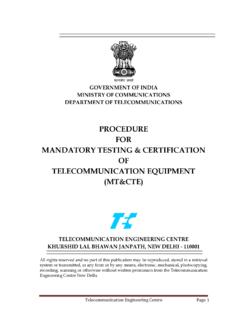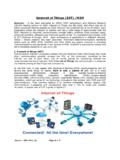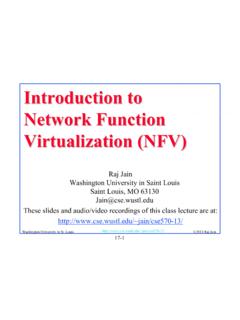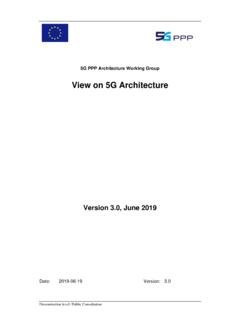Transcription of “Machine-to-Machine Communication (M2M)”
1 white paper on Machine-to-Machine Communication (M2M) INDEX 1. Introduction - Definition of M2M 2. Applications of M2M 3. Key features of M2M 4. Architecture and components of M2M 5. Requirements for M2M 6. Issues /concerns in M2M 7. Standardization Efforts for M2M 8. Conclusion Glossary 1 Machine-to-Machine Communication (M2M) 1. Introduction Machine-to-Machine (M2M) Communication is a form of data Communication that involves one or more entities that do not necessarily require human interaction or intervention in the process of Communication . M2M is also named as Machine Type Communication (MTC) in 3 GPP. It is different from the current Communication models in the ways that it involves: - new or different market scenarios - lower costs and effort - a potentially very large number of communicating terminals - little traffic per terminal, in general M2M Communication could be carried over mobile networks ( GSM-GPRS, CDMA EVDO networks).
2 In the M2M Communication , the role of mobile network is largely confined to serve as a transport network. With a potential market of probably 50 million connected devices, M2M offers tremendous opportunities as well as unique challenges. These devices vary from highly-mobile vehicles communicating in real-time, to immobile meter-reading appliances that send small amounts of data sporadically. 2. Applications of M2M The applications of M2M cover many areas and the areas in which M2M is currently used are given below: a. Security : Surveillances, Alarm systems, Access control, Car/driver security b. Tracking & Tracing : Fleet Management, Order Management, Pay as you drive, Asset Tracking, Navigation, Traffic information, Road tolling, Traffic optimization/steering c.
3 Payment : Point of sales, Vending machines, Gaming machines d. Health : Monitoring vital signs, Supporting the aged or handicapped, Web Access Telemedicine points, Remote diagnostics e. Remote Maintenance/Control : Sensors, Lighting, Pumps, Valves, Elevator control, Vending machine control, Vehicle diagnostics f. Metering : Power, Gas, Water, Heating, Grid control, Industrial metering g. Manufacturing : Production chain monitoring and automation h. Facility Management : Home / building / campus automation 2 3. Key features of M2M Some of the key features of M2M Communication system are given below: a. Low Mobility : M2M Devices do not move, move infrequently, or move only within a certain region b. Time Controlled : Send or receive data only at certain pre-defined periods c. Time Tolerant : Data transfer can be delayed d.
4 Packet Switched : Network operator to provide packet switched service with or without an MSISDN e. Online small Data Transmissions: MTC Devices frequently send or receive small amounts of data. f. Monitoring: Not intend to prevent theft or vandalism but provide functionality to detect the events g. Low Power Consumption : To improve the ability of the system to efficiently service M2M applications h. Location Specific Trigger : Intending to trigger M2M device in a particular area wake up the device 4. Architecture and components of M2M Figure 1 shows a simple architecture of M2M systems with its components. The various components and elements of an M2M system are briefly described below: a. M2M Device: Device capable of replying to request for data contained within those devices or capable of transmitting data autonomously.
5 Sensors and Communication devices are the endpoints of M2M applications. Generally, devices can connect directly to an operator s network, or they will probably interconnect using WPAN technologies such as ZigBee or Bluetooth. Backhaul to an operator s network is than achieved via gateways that encapsulate and manage all devices. Consequently, addressing and identifying, , routing, of the devices relies heavily on the gateways. Devices that connect via gateways are normally outside the operator s responsibility but belong to M2M applications that are provided by service or application providers. Sensors and devices that connect directly into an operator s network (via embedded SIM, TPM and radio stack or fixed line access) are endpoints of the network.
6 Thus, the responsibility in terms of accountability, SLAs etc., lies within the network operator (or virtual network operator). This holds true especially with respect to TPM where it is necessary to ensure that the module is really that reliable and well protected. b. M2M Area Network (Device Domain): Provide connectivity between M2M Devices and M2M Gateways, personal area network. 3 c. M2M Gateway: Equipment that uses M2M capabilities to ensure M2M Devices inter-working and interconnection to the Communication network. Gateways and routers are the endpoints of the operator s network in scenarios where sensors and M2M devices do not connect directly to the network. Thus, the task of gateways and routers are twofold. Firstly, they have to ensure that the devices of the capillary network may be reached from outside and vice versa.
7 These functions are addressed by the access enablers, such as identification, addressing, accounting etc., from the operator s platform and have to be supported at the gateway s side as well. Thus, platform and gateway form a distributed system, where generic and abstract capabilities are implemented on the gateway s side. Consequently, there will be a control flow between gateway and operator s platform that has to be distinguished from the data channel that is to transfer M2M application data. Secondly, there may be the need to map bulky internet protocols to their lightweight counterpart in low-power sensor networks. However, the latter application might lose its relevance since there are implementations of IPv6 for sensor networks available, that allow an all-IP approach.
8 D. M2M Communication Networks (Network Domain): It covers the communications between the M2M Gateway(s) and M2M application(s), xDSL, LTE, WiMAX, and WLAN. Figure 1: Architecture of M2M system 4 e. M2M Applications: It contains the middleware layer where data goes through various application services and is used by the specific business-processing engines. M2M applications will be based on the infrastructural assets ( , access enablers) that are provided by the operator. Applications may either target at end users, such as user of a specific M2M solution, or at other application providers to offer more refined building blocks by which they can build more sophisticated M2M solutions and services. customer care functionality, elaborate billing functions, etc.
9 Those services, or service enablers, may be designed and offered by an application provider, but they might be offered by the operator via the operator platform itself. Figure 2 shows the M2M system with examples of various components and applications. Figure 2: Examples of components of M2M system 5. Requirements for M2M Some of the general requirements for the M2M System, as specified by ETSI, are given below. 5 a. M2M Application Communication principles: The M2M system shall be able to allow Communication between M2M Applications in the Network and Applications Domain, and the M2M Device or M2M Gateway, by using multiple Communication means, SMS, GPRS and IP Access. Also a Connected Object may be able to communicate in a peer-to-peer manner with any other Connected Object.
10 The M2M System should abstract the underlying network structure including any network addressing mechanism used, in case of an IP based network the session establishment shall be possible when IP static or dynamic addressing is used. b. Message Delivery for sleeping devices: The M2M System shall be able to manage Communication towards a sleeping device. c. Delivery modes : The M2M System shall support anycast, unicast, multicast and broadcast Communication modes. Whenever possible a global broadcast should be replaced by a multicast or anycast in order to minimize the load on the Communication network. d. Message transmission scheduling: The M2M System shall be able to manage the scheduling of network access and of messaging. It shall be aware of the scheduling delay tolerance of the M2M Application.












